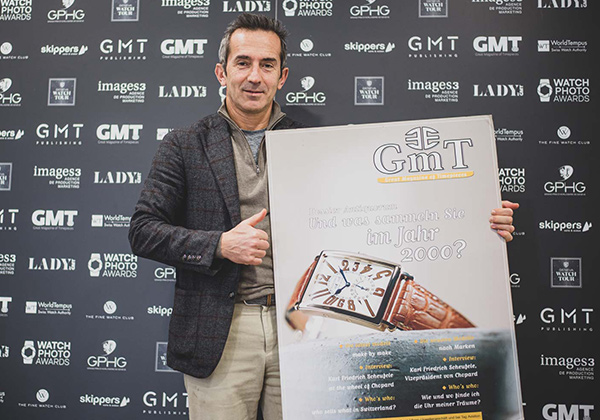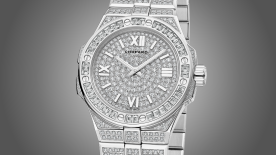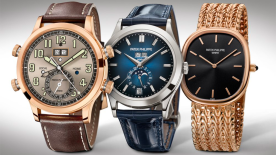One might as well state right from the word go that nobody in the watch industry knew either Brice Lechevalier or Pierre Jacques when they set out to launch a watch magazine at the turn of the third millennium. The former was carving out a career in the tourism industry, along with writing articles on marketing, travel and, more recently, watches, while the latter was involved in publishing. They met when Pierre Jacques suggested advertising in the Agenda Etudiant, which he had created, to Brice Lechevalier – then marketing director of Club Méditerranée in Switzerland and later of Sunsail, a worldwide leader in the yacht charter business (hence the subsequent parallel launch of the magazine Skippers, voile & océan). Having become friends and sharing the same passion for watchmaking, they embarked on the somewhat crazy idea of publishing a national watch magazine aimed at wealthy end consumers. At the time, no high-quality publication existed in this particular niche.
Targeting watch buyers
The pair’s credo was to offer an aesthetically pleasing watch magazine aimed at established watch buyers: customers in boutiques, affluent Swiss residents, as well as businesspeople and tourists passing through Swiss palace hotels... without waiting for these different populations to find the magazine on newsstands. GMT thus became Switzerland’s first free luxury magazine. At the time, magazines were not distributed in hotels or at retailers, and the latter were immediately drawn to this high-quality gift – all the more practical in that GMT is trilingual (German, English, French) – which they could offer their customers.
Three people were particularly enthusiastic about the concept presented by the two GMT colleagues and contributed to the success of its launch by endorsing the project. Patrick Cremers, then Branch Manager of the Les Ambassadeurs boutique in Geneva, said he was convinced of the relevance of this effective promotional tool for watches among final consumers and conveyed his enthusiasm to the brands he represented by advising them to place advertising in it. Osvaldo Patrizzi, founder of Antiquorum auction house, understood the value of reaching new customers through this medium and agreed to send each issue of the magazine to his entire collector base in exchange for editorial visibility in GMT. Finally, the Swiss director of the Financial Times, Stefan De Muynck, did the same with his subscribers. How could advertisers not be convinced of the relevance of this audience? To this very day, private Swiss subscribers to the Financial Times continue to have GMT delivered to their doorsteps.

Baselworld 2000
The first issue of GMT was published in March 2000, on the occasion of Baselworld, followed directly by the Salon International de la Haute Horlogerie (SIHH). It was met with varying degrees of enthusiasm. Many welcomed the initiative, but as the two founders of GMT still remember, certain brands not only did not agree to welcome them onto their booths, but were even not prepared to give them a press kit. It should be pointed out that the photo by Denis Hayoun (a still unknown photographer at the time) that appeared on the magazine cover might be regarded as somewhat perplexing: a flowerpot holding a Roger Dubuis MuchMore watch. The picture was chosen by the brand’s Communication Director at the time, Esthel Brunschwick; and then CEO Carlos Diaz warned them: “With a Roger Dubuis on your first cover, either everyone hates you and you’re finished, or it will be a great success!” Other more traditional Maisons decided to trust them for the inaugural edition, such as Vacheron Constantin – whose brand manager at the time was a certain Julien Tornare, now CEO of Zenith – and Ebel during its grand “Architects of Time” era.
Interpreted in various sizes and for different countries
In 2002, on the occasion of the Time trade fair that was held that same year, the two partners launched a Belgium-Luxembourg version of GMT. This unfortunately had to be abandoned after two years as they struggled to secure payments from local advertisers. The Time watchmaking exhibition in Brussels also suffered the same fate. But that same year, GMT XXL was launched, targeting summer customers in the Middle East with its unprecedented large format. In 2004 it was GMT Stars&Snow’s turn to appear in an intermediate size between the standard GMT A4 format and the XXL A3 variation, this time targeting wealthy tourists frequenting Swiss ski resorts in winter.
GMT XXS followed in 2007, created for women who could slip it into their handbag and becoming the first magazine entirely devoted to ladies’ watches and jewellery. Since then, it has been transformed into GMT Lady and returned to the standard GMT format so as to provide a better showcase for products, taking its place as the only women’s magazine in any field to appear in both German- and French-speaking areas of Switzerland. That same year (2013), at the request of the watch brands, and to optimise distribution efficiency, GMT Stars&Snow also adopted the standard A4 format and was renamed GMT Winter.
Meanwhile, the internationalisation of GMT accelerated from 2004 onwards, helped by its differentiation in terms of format (the GMT XXL version was selected for the foreign market) along with the outstanding quality of its production. GMT XXL USA blazed the trail, followed by GMT XXL Russia-Ukraine and GMT XXL Paris-Monaco, prefaced by designer Philippe Starck.

GMT changes hands, although...
During the mid-2000s which proved a prosperous economic period, particularly for the press and the watch industry, GMT received several takeover offers, including from as far afield as India. The bid that best matched the founders’ vision – which was to ensure the long-term survival of the title – was made by Edipresse, a major Swiss media group. The change of ownership took place in two steps between 2007 and 2009. During this transitional phase, GMT was launched in Asia by the local subsidiary of Edipresse, but this initiative was quickly halted by the financial crisis that erupted around the world. Henceforth freed from their contractual commitments, the two partners were able to choose whether they wished to take their careers in another direction. This was the option taken by Pierre Jacques, who became Branch Manager of Les Ambassadeurs Genève and, at the same time, Managing Director of the Grand Prix d’Horlogerie de Genève (GPHG). After a year, he left both positions to join the De Bethune company, where he became CEO.
For his part, at the request of Edipresse, Brice Lechevalier continued to serve as Chief Editor of GMT, although his actual role extended far beyond that. The separation from his other partner, Christian Bugnon, in the company with which he had created Skippers and other magazines also took place in 2009. Brice Lechevalier kept Skippers and Christian Bugnon the magazine 30°. That same year, Skippers became the official publication of the Swiss Sailing Federation. At the same time, Edipresse sold all its activities in Swiss media, retaining only GMT and a certain watchmaking site, WorldTempus, which was initially managed by an agency. In view of the unfailing commitment shown by the founder who remained on-board, and his influence within the watchmaking community, the Lamunière family, owners of Edipresse, offered him an opportunity in 2012 to acquire half the shares in GMT and to create the GMT Publishing joint venture so as to develop all watchmaking activities together.
Brice Lechevalier sets the tempo
In 2012, once again officially co-owner of GMT, Brice Lechevalier created the Geneva Watch Tour and supported Carlo Lamprecht (then president of the GPHG) in instating the 12th Art, the Art of Time Measurement, thereby strengthening GMT’s ties with the GPHG. In 2013, GMT became the only B2C watch magazine (aimed at end consumers) whose circulation is controlled and certified by the REMP, a guarantee of reliability for the brands and their media-plan return on investment. That same year, the Chief Editor followed the advice of several major brands and unified the GMT XXL versions published outside Switzerland into a single title: GMT XXL World.
This annual special edition is published simultaneously in 80 countries with a print run of 100,000 copies, targeting wealthy individuals and collectors worldwide. Its eighth edition was released in September 2020 at Homo Faber and the Cannes Yachting Festival. With six issues per year (in addition to the XXL World), GMT became the Swiss B2C watch magazine with the highest publication frequency. In 2014, the Lamunière family and Brice Lechevalier decided to broaden the scope of their joint venture, by bringing WorldTempus and Skippers within the ambit of GMT Publishing. The synergies are obvious, and the two complementary specialised watch media have established themselves as watchmaking references in print and on the web.
President of the Federation of the Swiss Watch Industry, Jean-Daniel Pasche chose GMT to extend his best wishes to the watchmaking world in 2015 via the magazine’s preface. Other leading figures in the industry also engaged in this exercise, such as Fabienne Lupo, then Managing Director of the SIHH, and Luc Pettavino, founder of Only Watch, with which GMT has kept step since the very beginning. Among insiders, GMT has always been known for its festive and popular watch-themed evenings that took on a whole new dimension at the SIHH 2016 – the year the famous after-parties held on boats vanished. More than 600 people from the industry flocked to the GMT soiree organised during the Geneva show. The event was held each year until 2019.
Since 2018, Brice Lechevalier has strengthened the GMT ecosystem by creating the Watch Photo Awards (the first international watch photo competition for the general public) and the Fine Watch Club (the first international watchmaking club). He has also signed two new franchises for the magazine, GMT Middle East and GMT Africa, both published quarterly.

In 2020, the focus is on Asia and a cult book
In addition to a party scheduled for this autumn in Geneva, GMT is also celebrating its 20th anniversary in several ways throughout the year. In Switzerland, distribution is being strengthened through a national partnership with high-end retailer Bongénie, which is placing it in all its men’s departments. With his associates, owners of Tatler magazine in Asia, a leading title in the Asian luxury press, Brice Lechevalier is creating Tatler x GMT, a new publication covering the eight markets in which Tatler is present, including China. Tatler x GMT merges GMT’s watchmaking expertise with Tatler’s knowledge of Asian-style luxury. Its 100,000-copy circulation ranks it at the very top of Asia’s leading luxury watch magazines. Its first issue will be officially presented this fall. Also in Asia, a new franchise is being created with GMT Korea, initiated by a local publisher specializing in fine magazines (cuisine, fashion, travel). The first issue of this high-quality Korean watch quarterly will be published in the autumn 2020.
Finally, since last summer, the GMT (and WorldTempus) team has been working on a book intended to become a reference in watchmaking literature, covering 20 years of watchmaking from 2000 to 2020: The Millennium Watch Book. Experts from all over the world who have been involved in or have witnessed this intense period are participating in the preparation of this work, due to be published in the autumn.
Subscriptions are possible from May onwards on the-watch-book.com and further information is available on GMTPublishing, Instagram, Facebook and WorldTempus



